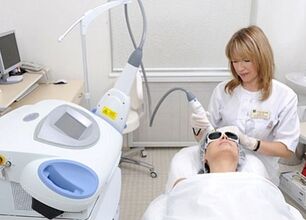
The aging process is a natural biological law of any human organism. Inevitably, signs of skin discoloration in the form of wrinkles, decreased tone, and age spots appear on various parts of the body. The face, due to the constant influence of ultraviolet radiation, the work of the facial and chewing muscles, is especially prone to withering. For obvious reasons, women of all ages want to keep their faces fresh and youthful. In such a situation, not only creams and masks come to the rescue, but also skin rejuvenation by fractional exposure.
The essence and advantages of the method
Technology is the exposure of high frequency energy to the skin. Beams of a certain wavelength produce thermal reactions, or rather, evaporate cells to a predetermined depth. The disappearance of some cells causes the synthesis of collagen and elastin fibers. With age, there is a significant reduction in the synthesis of collagen and elastin in the thickness of the skin. It is these fibers that give elasticity and youth to the skin, in fact, they are the building material of the epidermis and dermis. Thus, under the action of the laser, the face is rejuvenated.
Laser resurfacing is a modern technique that has proven itself in the cosmetology services market. Let's see some of the benefits:
- Fractional treatment is an absolutely painless procedure. Even the slightest discomfort, according to reviews, is absent.
- The technology involves minimal damage to the skin, so that the traces after the therapy disappear in 4-5 days.
- Technology allows you to work in a large area at a time. This approach maximally activates regenerative processes, leading to active wrinkle smoothing.
Side effects and adverse reactions after the described intervention are extremely rare. The most typical are hyperemia and desquamation in the treatment area, moderate itching that is self-healing. Sometimes there is an activation of herpes infection. With frequent exacerbations of herpes, a consultation with a dermatologist and an infectious disease specialist is necessary before conducting fractional rejuvenation.
What is the course of treatment?
A therapy session lasts 25 to 40 minutes. Reparative therapy can be applied to the face, neck and décolleté. In the office, the patient is lying down and can relax.
For maximum effect, 3-4 procedures are required. The optimal interval between sessions is 2 to 4 weeks. During this time, the epidermis and dermis fully regain their regenerative potential. The standard course consists of 4 procedures. The most pronounced visual effect is noticeable 3 months after the end of the course. If necessary, sessions can be repeated after 1 year.
In the end, there is a high probability of itching or mild burning sensation, which will stop automatically after 1-2 hours. Hyperemia and unexpressed swelling persist for 2-3 days. During the early recovery period, dermatologists recommend the use of dextpanthenol healing sprays and ointments.
Hygienic care is allowed on the day of the intervention, only one visit to a bathroom or pool should be limited during the week. Do not neglect sunscreens: the integuments after treatment are especially sensitive to ultraviolet light.
Fractional exposure is an effective method, whose effect on the signs of aging has been proven by scientific research. The safety, painless and comfort of the intervention make it one of the most popular in the practice of cosmetology.


























































